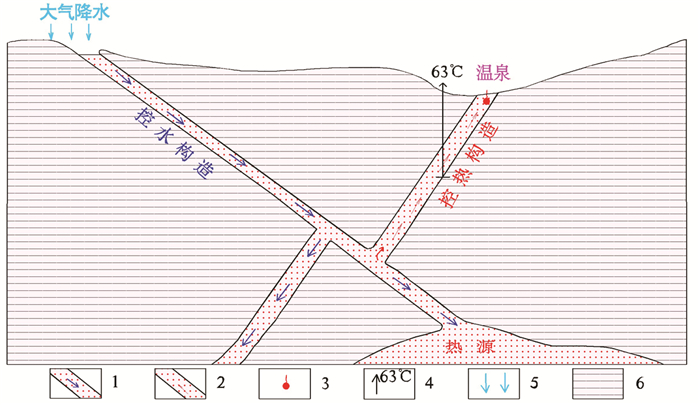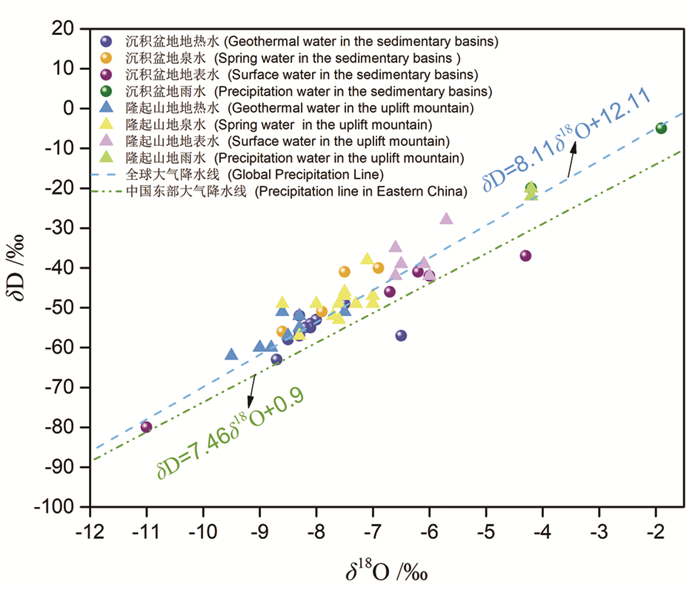Characteristics and potential evaluation of geothermal resources in Anhui of Yangtze River Economic Zone
-
摘要:
研究目的 安徽长江经济带地热资源储量丰富,未来开发利用前景好,对该区域进行地热资源评价可为安徽省能源结构优化及地热资源可持续开发利用提供科学依据。
研究方法 在分析研究区地质构造、地层岩性、地热流体水化学类型等地质与水文地质条件的基础上,揭示了安徽长江经济带地热资源概况及分布特征,探讨了隆起山地对流型和沉积盆地传导型地热资源的赋存特征,并对其储量及开发利用潜力进行评价。
研究结果 安徽长江经济带地热资源热储主要赋存在巢湖—和县基岩隆起区、大别山隆起区、沿江基岩隆起区、江南隆起等隆起山地及定远断陷盆地、肥东断陷盆地、霍山—九井盆地、庐枞断陷盆地、安庆断陷盆地、宣城断陷盆地等沉积盆地。前者隆起区热储类型为带状,岩性以断裂破碎带中花岗岩为主,后者断陷盆地热储类型为层状及层状兼带状,岩性以砂岩和碳酸盐岩为主。带内热储主要为偏硅酸·氟热矿水,隆起山地型地热流体水化学类型主要为SO4、HCO3型水,沉积盆地型地热流体水化学类型主要为HCO3型水。通过潜力评价可知,隆起山地型地热资源潜力较小,且处于开发利用状态的地热田基本处于超采状态;沉积盆地型地热资源潜力相对较大,其中潜力大、中和小的盆地分别有4处、6处和10处。
结论 安徽长江经济带区域内地热资源潜力分布不均,地热资源需要分区规划利用,并且需要考虑高氟、高矿化度热矿水利用造成的地表水环境污染。
Abstract:This paper is the result of geothermal resource survey engineering.
Objective The geothermal resources in Anhui of Yangtze River Economic Zone are abundant, which has good prospects for city development and utilization. The evalution of geothermal resources can provide a scientific basis for the optimization of energy structure, sustainable development and utilization of geothermal resources in this area.
Methods Through analyzing the geological and hydrogeological conditions, e.g., geological structure, formation lithology, and hydrochemical composition of geothermal fluids, this study reveals the distribution characteristics of geothermal resources in Anhui of Yangtze River Econmic Zone, discusses the storage feature of geothermal resources in uplift mountain convective area and conductive-type sedimentary basins, and evaluates its reserves, development, and utilization potential.
Results The geothermal resources mainly occurred in the uplift mountain including the Chaohu-Hexian bedrock, the Dabie mountain, the bedrock along the Yangtze River, the Jiangnan, and at the sedimentary basin including the Dingyuan, the Feidong, the Huoshan-Jijing, the Luzong, the Anqing, and the Xuancheng, etc. The thermal storage of the former uplift mountain is zonal-type, dominated by granite in the fractured zone of the area. The thermal storage of the latter sedimentary basin is layered and layered-zonal type, dominated by lithologic sandstones and carbonate rocks. The thermal storage is mainly metasilicic acid-fluorine thermal mineral water. The hydrochemical type of the geothermal fluid in uplift-mountain type are mainly SO4 and HCO3 type. The hydrochemical type of geothermal fluid in sedimentary-basin type is mainly HCO3 type. According to the potential evaluation results, the utilization potential of geothermal resources in uplift mountain type is relatively small and is basically in over-exploitation situation while that in sedimentary-basin type is relatively large. There are 4, 6, and 10 basins with big, medium, and small potential in sedimentary-basin type geothermal resources.
Conclusions The potential distribution of geothermal resources in Anhui of Yangtze River Economic Zone is uneven, and the geothermal resources need to be planned and utilized in different zones. It is necessary to consider the surface water pollution caused by the utilization of high fluoride and high salinity hot mineral water.
-

-
表 1 安徽长江经济带地热流体水化学成分
Table 1. Hydrochemical composition of geothermal fluids in Anhui of Yangtze River Economic Zone

表 2 安徽长江经济带地热田稳定同位素(δD和δ18O)测定值
Table 2. Stable isotope (δD and δ18O) values of geothermal fields in Anhui of Yangtze River Economic Zone

表 3 盆地地热流体资源量估算参数
Table 3. Estimation parameters of geothermal fluid resources in the basin

表 4 部分盆地内地热流体资源估算
Table 4. Estimation of thermal fluid resources in the interior of the part of the basins
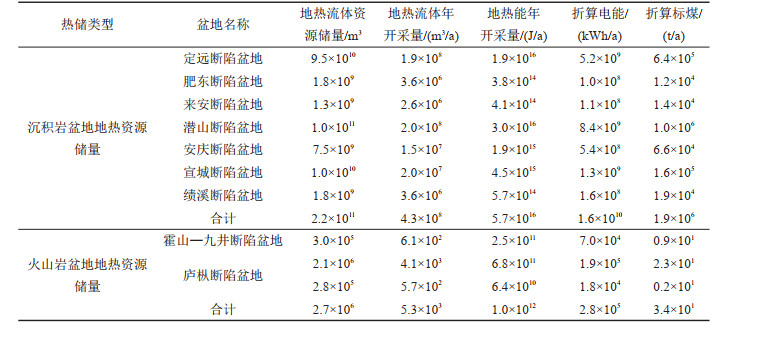
表 5 部分隆起山地地热流体资源估算
Table 5. Estimates of geothermal fluid resources in the part of uplift mountains
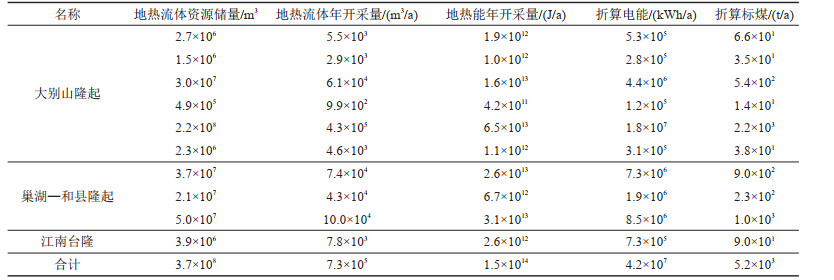
表 6 大别山隆起带和巢湖—和县隆起带地热资源潜力
Table 6. Geothermal resource potential of Dabie Mountain uplift and Chaohu-Hexian uplift

-
Cui Yueju, Sun Fengxia, Du Jianguo. 2022. Methods for identification of seismic geochemical precursors and source partitioning of hot spring fluids in Eastern Chinese Mainland[J]. Journal of Seismological Research, 45(2): 199-216(in Chinese with English abstract).
Jiang Yuehua, Lin Liangjun, Chen Lide, Ni Huayong, Ge Weiya, Cheng Hangxin, Zhai Gangyi, Wang Guiling, Ban Yizhong, Li Yuan, Lei Mingtang, Tan Chengxuan, Su Jingwen, Zhou Quanping, Zhang Taili, Li Yun, Liu Hongying, Peng Ke, Wang Hanmei. 2017. Research on conditions of resources and environment and major geological problems in the Yangtze River Economic Zone[J]. Geology in China, 44(6): 1045-1061(in Chinese with English abstract).
Jin Menggui, Zhang Jie, Zhang Zhixin, Cao Mingda, Huang Xin. 2022. A review on source identification of dissolved sulfate in groundwater: Advances, problems and development trends[J]. Bulletin of Geological Science and Technology, 41(5): 160-171(in Chinese with English abstract).
Lin Wenjing, Wang Guiling, Shao Jingli, Gan Haonan, Tan Xianfeng. 2021. Distribution and exploration progress of hot dry rock resources in China: Progress and inspiration[J]. Acta Geologica Sinica, 95(5): 1366-1381(in Chinese with English abstract). doi: 10.3969/j.issn.0001-5717.2021.05.004
Liu Hai. 2020. Research on Genesis and Development of Geothermal System in Wanjiang Economic Belt[D]. Chengdu: Chengdu University of Technology (Chengdu), 34-35(in Chinese with English abstract).
Ma Bing, Jia Lingxiao, Yu Yang, Wang Huan. 2021. The development and utilization of geothermal energy in the world[J]. Geology in China, 48(6): 1734-1747(in Chinese with English abstract).
Pan Guolin. 2011. Characteristics of geothermal resources and the division of prospecting areas in Anhui Province[J]. Chinese Journal of Geological Hazards and Prevention, 22(2): 130-134(in Chinese with English abstract).
Pan Liangyun, Meng Lingjian, Sun Fuli, Yang Wenjun, Zhang Wei, Ren Lu, Xue Hui, Zhou Bo, Yang Hui. 2022. Geothermal geological characteristics and resource potential in the north of Datong Basin, Shanxi Province[J]. Geology in China, 1-14 https://kns.cnki.net/kcms/detail/11.1167.P.20220607.1040.002.html (in Chinese with English abstract).
Qin Teng, Tong Jinping. 2021. Spatiotemporal change of water-energy-food coupling efficiency and influencing factors in the Yangtze River Economic Belt[J]. Resources Science, 43(10): 2068-2080(in Chinese with English abstract). doi: 10.18402/resci.2021.10.11
Su Guifen, Li Fanggen, Han Xiaonan. 2018. Study on geothermal potential of tectonic basins and deep fault in Southern Anhui Province[J]. Sino-Global Energy, 23(7): 15-24(in Chinese with English abstract).
Wang Guiling, Li Kewen, Wen Dongguang, Lin Wenjing, Lin Liangjun, Lin Zhiming, Zhang Wei, Ma Feng, Wang Wanli. 2013. Assessment of geothermal resources in China[C]//Proceedings, Thirty-Eighth Workshop on Geothermal Reservoir Engineering, Stanford University, Stanford, California, Febuary. 11-13.
Wang Guiling, Lin Wenjing. 2020. Main hydro-geothermal systems and their genetic models in China[J]. Acta Geologica Sinica, 94(7): 1923-1937(in Chinese with English abstract). doi: 10.3969/j.issn.0001-5717.2020.07.002
Wang Guiling, Zhang Wei, Lin Wenjing, Liu Feng, Zhu Xi, Liu Yanguang, Li Jun. 2017. Research on formation mode and development potential of geothermal resources in Beijing-Tianjin-Hebei region[J]. Geology in China, 44(6): 1074-1085(in Chinese with English abstract).
Wang Guilling, Wang Wanli, Luo Jin, Zhang Yuhao. 2019. Assessment of three types of shallow geothermal resources and ground-source heat-pump applications in provincial capitals in the Yangtze River Basin, China[J]. Renewable and Sustainable Energy Reviews, 111: 392-421. doi: 10.1016/j.rser.2019.05.029
Wang Jiyang, Hu Shengbiao, Pang Zhonghe, He Lijuan, Zhao Ping, Zhu Chuanqing, Rao Song, Tang Xiaoyin, Kong Yanlong, Luo Lu, Li Weiwei. 2012. Estimate of geothermal resources potential for hot dry rock in the continental area of China[J]. Science &Technology Review, 30(32): 25-31(in Chinese with English abstract).
Wang Jiyang, Sun Zhanxue, Pang Zhonghe, Hu Shengbiao. 2015. Geothermics and its Application[M]. Beijing: Science Press, 12-16(in Chinese with English abstract).
Wang Jiyang, Xiong Liangping, Pang Zhonghe. 1993. Medium and Low Temperature Convection Geothermal System[M]. Beijing: Science Press, 55-57(in Chinese with English abstract).
Wen Huaguo, Huo Fei, Guo Pei, Ning Meng, Liang Jintong, Zhong Yijiang, Su Zhongtang, Xu Wenli, Liu Sibing, Wen Longbin. 2021. Advances and prospects of dolostone-evaporite paragenesis System[J]. Acta Sedimentologica Sinica, 39(6): 1321-1343(in Chinese with English abstract).
Wu Haiquan, Yang Zedong, Shu Qian, Cao Heng. 2016. Distribution characteristics of geothermal resources in Anhui Province and their development and utilization suggestions[J]. Journal of Geology, 40(1): 171-177(in Chinese with English abstract).
Xu Jiying, Gui Herong, Chen Jiayu, Li Ye, Zhao Chengzhou, Guo Yan. 2022. Hydrogeochemical characteristics and formation mechanisms of the geothermal water in the Qingdong coal mine, Northern Anhui Province, China[J]. Mine Water and the Environment, 41(4): 1015-1026. doi: 10.1007/s10230-022-00895-2
Xu Shiguang, Guo Yuansheng. 2009. Fundamentals of Geothermal Science[M]. Beijing: Science Press, 115-120(in Chinese with English abstract).
Yu Yan, Liu Jie, Kang Nan, Lin Wei, Gao Baozhu. 2013. The Q-Type cluster analysis of the relationship with geothermal fluid's hydrochemistry characteristics and geological structure[J]. Hydrogeology & Engineering Geology, 40(3): 131-135(in Chinese with English abstract).
Yu Yuan. 2006. A Study of Hydrochemistry and Isotopes in Thermal Groundwater in the Urban Geothermal Fileld, Beijing[D]. Beijing: China University of Geosciences (Beijing), 65-68(in Chinese with English abstract).
Zhang Ruirui, Wang Guiling, Shen Xiaoxu, Wang Jinfeng, Tan Xianfeng, Feng Shoutao, Hong Jinglan. 2020. Is geothermal heating environmentally superior than coal fired heating in China?[J]. Renewable and Sustainable Energy Reviews, 131: 110014.
崔月菊, 孙凤霞, 杜建国. 2022. 中国大陆东部温泉流体来源解析与地震地球化学异常判识方法[J]. 地震研究, 45(2): 199-216. https://www.cnki.com.cn/Article/CJFDTOTAL-DZYJ202202004.htm
姜月华, 林良俊, 陈立德, 倪化勇, 葛伟亚, 成杭新, 翟刚毅, 王贵玲, 班宜忠, 李媛, 雷明堂, 谭成轩, 苏晶文, 周权平, 张泰丽, 李云, 刘红樱, 彭柯, 王寒梅. 2017. 长江经济带资源环境条件与重大地质问题[J]. 中国地质, 44(6): 1045-1061. http://geochina.cgs.gov.cn/geochina/article/abstract/20170601?st=search
靳孟贵, 张结, 张志鑫, 曹明达, 黄鑫. 2022. 地下水硫酸盐溯源的进展、问题和发展趋势[J]. 地质科技通报, 41(5): 160-171. https://www.cnki.com.cn/Article/CJFDTOTAL-DZKQ202205018.htm
蔺文静, 王贵玲, 邵景力, 甘浩男, 谭现锋. 2021. 我国干热岩资源分布及勘探: 进展与启示[J]. 地质学报, 95(5): 1366-1381. https://www.cnki.com.cn/Article/CJFDTOTAL-DZXE202105004.htm
刘海. 2020. 皖江经济带地热系统成因及开发利用研究[D]. 成都: 成都理工大学, 34-35.
马冰, 贾凌霄, 于洋, 王欢. 2021. 世界地热能开发利用现状与展望[J]. 中国地质, 48(6): 1734-1747. http://geochina.cgs.gov.cn/geochina/article/abstract/20210606?st=search
潘国林. 2011. 安徽省地热资源特征及远景区划[J]. 中国地质灾害与防治学报, 22(2): 130-134. https://www.cnki.com.cn/Article/CJFDTOTAL-ZGDH201102026.htm
潘良云, 孟令箭, 孙福利, 杨文军, 张玮, 任路, 薛慧, 周博, 杨慧. 2022. 山西大同盆地北部地热地质特征及资源潜力[J]. 中国地质, 1-14. https://kns.cnki.net/kcms/detail/11.1167.P.20220607.1040.002.html
秦腾, 佟金萍. 2021. 长江经济带水-能源-粮食耦合效率的时空演化及影响因素[J]. 资源科学, 43(10): 2068-2080. https://www.cnki.com.cn/Article/CJFDTOTAL-ZRZY202110011.htm
苏贵芬, 李方根, 韩晓南. 2018. 安徽皖南地区构造盆地及深大断裂地热潜力研究[J]. 中外能源, 23(7): 15-24. https://www.cnki.com.cn/Article/CJFDTOTAL-SYZW201807003.htm
汪集旸, 胡圣标, 庞忠和, 何丽娟, 赵平, 朱传庆, 饶松, 唐晓音, 孔彦龙, 罗璐, 李卫卫. 2012. 中国大陆干热岩地热资源潜力评估[J]. 科技导报, 30(32): 25-31. https://www.cnki.com.cn/Article/CJFDTOTAL-KJDB201232017.htm
汪集旸, 熊亮萍, 庞忠和. 1993. 中低温对流型地热系统[M]. 北京: 科学出版社, 55-57.
汪集暘, 孙占学, 庞忠和, 胡圣标. 2015. 地热学及其应用[M]. 北京: 科学出版社, 12-16.
王贵玲, 蔺文静. 2020. 我国主要水热型地热系统形成机制与成因模式[J]. 地质学报, 94(7): 1923-1937. https://www.cnki.com.cn/Article/CJFDTOTAL-DZXE202007002.htm
王贵玲, 张薇, 蔺文静, 刘峰, 朱喜, 刘彦广, 李郡. 2017. 京津冀地区地热资源成藏模式与潜力研究[J]. 中国地质, 44(6): 1074-1085. http://geochina.cgs.gov.cn/geochina/article/abstract/20170603?st=search
文华国, 霍飞, 郭佩, 甯濛, 梁金同, 钟怡江, 苏中堂, 徐文礼, 刘四兵, 温龙彬, 蒋华川. 2021. 白云岩-蒸发岩共生体系研究进展及展望[J]. 沉积学报. 39(6): 1321-1343. https://www.cnki.com.cn/Article/CJFDTOTAL-CJXB202106002.htm
吴海权, 杨则东, 疏浅, 曹恒. 2016. 安徽省地热资源分布特征及开发利用建议[J]. 地质学刊, 40(1): 171-177. https://www.cnki.com.cn/Article/CJFDTOTAL-JSDZ201601023.htm
徐世光, 郭远生. 2009. 地热学基础[M]. 北京: 科学出版社, 115-120.
于彦, 刘杰, 康楠, 林溦, 高宝珠. 2013. 地热流体水化学特征与地质构造关系的Q-型聚类分析[J]. 水文地质工程地质, 40(3): 131-135. https://www.cnki.com.cn/Article/CJFDTOTAL-SWDG201303027.htm
于湲. 2006. 北京城区地热田地下热水的水化学及同位素研究[D]. 北京: 中国地质大学(北京), 65-68.
-



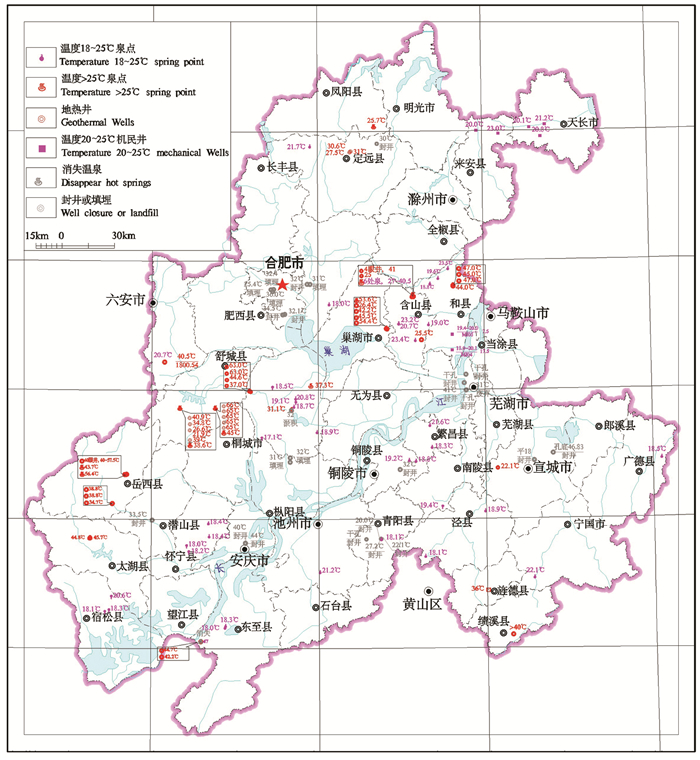
 下载:
下载:
